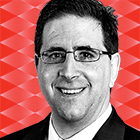This content is from:xinyabo体育app
2015年美国所有研究小组:Semiconductors, No. 1: Stacy Rasgon
Topping this roster for the first time is Stacy Rasgon, who has covered U.S. semiconductors names for Sanford C. Bernstein & Co. since April 2008.


Bernstein & Co.
Total Appearances: 4
Analyst Debut: 2012
Topping this roster for the first time isStacy Rasgon, who has covered U.S. semiconductors names for Sanford C. Bernstein & Co. since April 2008. Before launching his sell-side career, the Los Angeles–based researcher was an engagement manager at McKinsey & Co., primarily serving companies in this sector. Previously, while pursuing degrees in chemical engineering — a bachelor’s at the University of California, Los Angeles, and a Ph.D. at the Massachusetts Institute of Technology — Rasgon worked as a co-op engineer at California’s Spectrolab and New York’s IBM Corp. T.J. Watson Research Center. In 2010 and 2011 buy-siders named him a Rising Star of Wall Street Research, and one year later he debuted on this roster, as a runner-up. He claimed the No. 2 position in 2013 and the No. 3 spot last year. “Stacy is not afraid to challenge consensus thinking or challenge management teams when necessary,” one supporter affirms. “He is one of the few analysts that call out management teams for excessive pay packages.” In monitoring eight U.S. semiconductors names, Rasgon, 41, “publishes deep, insightful research into the underpinnings of the entire semiconductor industry,” a second fund manager relates. The Bernstein analyst began this year with a “reasonably positive view” but has since become increasingly wary on the sector. “I got more cautious in June,” he says. “Currently, the near-term cyclical indicators have gotten less favorable, and there appears to be increased macro risk along with China uncertainty.” He expects these headwinds to persist into 2016. “Weakness earlier in the year — mostly around PCs and communications — has intensified, and new pockets of weakness, such as in smartphones and potentially industrial, seem to be appearing,” adds Rasgon, 41. “Beyond the macro the group overall faces the specter of increasing competition in historically high-growth areas like smartphones, increased difficulty in manufacturing and design — the oft-speculated ‘end of Moore’s Law’ — and an overall maturation.”
